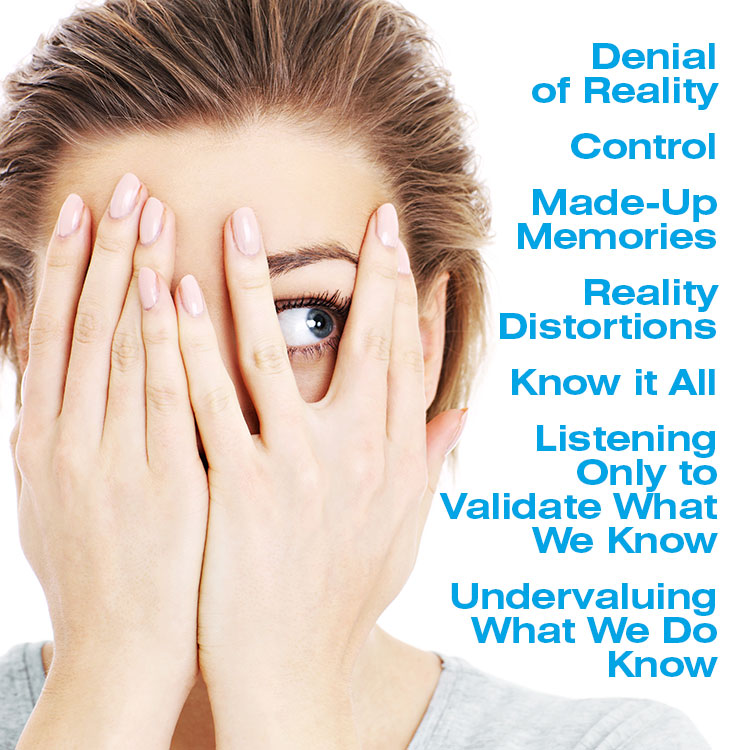By Judith E. Glaser | c-suitenetwork.com
Published: February 20, 2015
Many of us act as though we all see the same reality, yet the truth is we don’t. Human beings have cognitive biases, or blind spots. Blind spots are ways our mind becomes blocked from seeing reality as it is — blinding us from seeing the real truth about ourselves in relation to others. Once we form a conclusion, we become blind to alternatives, even if they are right in front of their eyes.
Social psychologist Emily Pronin, along with colleagues Daniel Lin and Lee Ross at Princeton University’s Department of Psychology, created the term “bias blind spots,” named after the visual blind spot.
Passing the Ball
There is a classic experiment that demonstrates one level of bias blind spots that can be attributed to awareness and focused attention. When people are instructed to count how many passes the people in white shirts make on the basketball court, they often get the number of passes correct but fail to see the person in the black bear suit walking right in front of their eyes. Hard to believe but true!
Blind Spots and Denial
However, the story of blind spots gets more interesting when we factor in cognitive biases stemming from our social needs to look good in the eyes of others. Blind spots, coupled with a strong ego, often makes people refuse to adjust their course, even in the face of opposition from trusted advisers — or incontrovertible evidence to the contrary.
Two well-known examples of blind spots are Henry Ford and A&P:
- Ford’s success with the one-option Model-T blinded him to the desires of his customers, allowing fledging General Motors to capture a winning share of the automobile market with a broader range of models.
- A&P stuck with the grocery chain’s private label products even as their customers defected en masse to supermarkets that carried the national brands advertised on TV.
Recovery
The good news is that companies can recover from denial, even when they seem permanently wedded to their histories, their philosophies or their belief systems. IBM, a victim of its own “bureau-pathology,” learned to conquer its arrogance and overcome its history and culture under the innovative leadership of Louis Gerstner.
Intel, DuPont, and Coca-Cola are more examples of corporations caught in denial traps when launching new products. They demonstrated that when corporate management has strong convictions — or worse yet, hubris about their points of view — they can become blind to their customer’s needs, which are right in front of their very eyes.
Seeing the real truth is an art and a science. When we find the balance between what we think is true and what is really true, we are managing our blind spots with integrity and wisdom.
Fortunately, these well-known brands did not live in denial very long. It was only a passing phase, and they recovered by revisiting reality with an open mind. Blind spots explain why the “smartest people in the room” (as Enron’s top executives were famously called) can sometimes be very dumb. They do not see the light — they are not open to changing their minds.
The Power of Coaching to Dissolve Blind Spots
Denial and blind spots make Conversational Coaching so vital for leaders, and also demonstrate why peer coaching is equally important for employees. Conversational Coaching can effectively uncover and deal with blind spots and denial and give the decision-makers a fresh perspective on how to handle executive challenges.
C-IQ Coaching also helps individuals gain a broader and more realistic perspective about both situations and themselves. Executive, Team and Organizational Coaching can help leaders calibrate with the world around them, giving them reality checkpoints that position them to navigate the real world with wisdom and insight.
Occasionally, we all need a wake-up call in order not to confuse our denial maps with the actual territory.
Check Yourself
Here are 7 Common Blind Spots:
- Denial of Reality: Feeling so strongly about our own beliefs that we deny the beliefs of others, or deny facts right in front of our eyes.
- Control: Seeing ourselves as being more responsible for things than we actually are, or having more control over things and events than we truly do.
- Made-Up Memories: Making decisions based on memories that did not happen. Often we confuse our imaginations, or our dreams, with reality.
- Reality Distortions: Distorting reality to conform to preconceptions.
- Know it All: Thinking that we know more than what we really do. (We simply don’t know what we don’t know.)
- Listening Only to Validate What We Know : Failure to listen to others.
- Undervaluing What We Do Know: Listening too much to others, and allowing others’ beliefs to talk us out of our beliefs; or in some cases cause us not to trust our instincts.
Neuro-tips: Removing Blind Spots
Tip #1 – It Takes Thought to Learn. The brain does not always allow us to hear all the facts if they do not fit our prior understanding of a concept. To learn new facts, you must be actively open to accepting opposition.
Tip #2 – Effectively Working Together. Partners who were considered controlling were perceived as critical and rude, and their advice was generally rejected and not trusted. When the same partners showed appreciation, a feeling of rapport and trust developed, creating a deep “WE-centric” bond.
Shaping the Quality of the Conversational Environment
Every conversation has an impact. You may not see it at first. It takes place inside of us at the speed of .07 seconds. It takes place at the cellular level. Cells talk with each other, and if a conversation feels bad—our fear networks are activated instantly. Blood rushes to our primitive brain, which is designed for protection, cortisol (a fear hormone) is spray-painted everywhere, and our ability to protect ourselves from harm is turned on instantly.
Did you ever notice that, during a meeting or brainstorming session, one comment from a powerful voice can stop the innovation process? Simple comments such as, “how could you think that,” or “what where you thinking?” activate our fear network and without realizing it, colleagues can inadvertently and unintentionally turn the “innovation lights out.”
The quality of conversations does matter. Quality conversations establish the environments and readiness to support innovation.
Pathways to Success:
- Step 1: Encourage Candor and Trust.
Straight talk, candor and open conversations (without repercussions and fear of punishment) are the operating norm for innovative conversations. Employees need to trust that their ideas will be heard — and that they will get support, attention and proper vetting once the ideas are put on the table. Shaping the quality of the conversational environment enables employees to speak up, and share their innovative thinking. - Step 2: Eliminate Politics.
Organizations have unwritten codes that signal “you can’t say this,” or “you can’t do that.” These tell people they are unsafe to challenge the status quo. People are afraid to speak up. Conversations go to the lowest common denominator — people stop innovating. However, when shaping the quality of the conversational environment for safety, employees trust they will get quality feedback on their ideas, and they speak up. - Step 3: Promote Recognition.
Too often employees have great ideas, and no one listens. When ideas are expressed, no one validates them or acknowledges them. There is an instinctive fear in many of us that our voices will not be heard, and our ideas will be pushed under the rug or their importance minimized. Shaping the quality of the conversational environment with conversational norms that enable employees to be celebrated for having great ideas changes the amount of great ideas that show up. When employees can trust that they will get the recognition from the top for being “idea catalysts,” management will find that people have a lot to say!
Ask Yourself…
- What does the organization need to know but does not because people are afraid to speak up?
- What are you doing to create trusting, non-toxic work environments?
- What are the unwritten codes or norms that are at play that may be inhibiting open, candid, trusting conversations?
- What can you do as a leader to create trust?
See more at: c-suitenetwork.com









